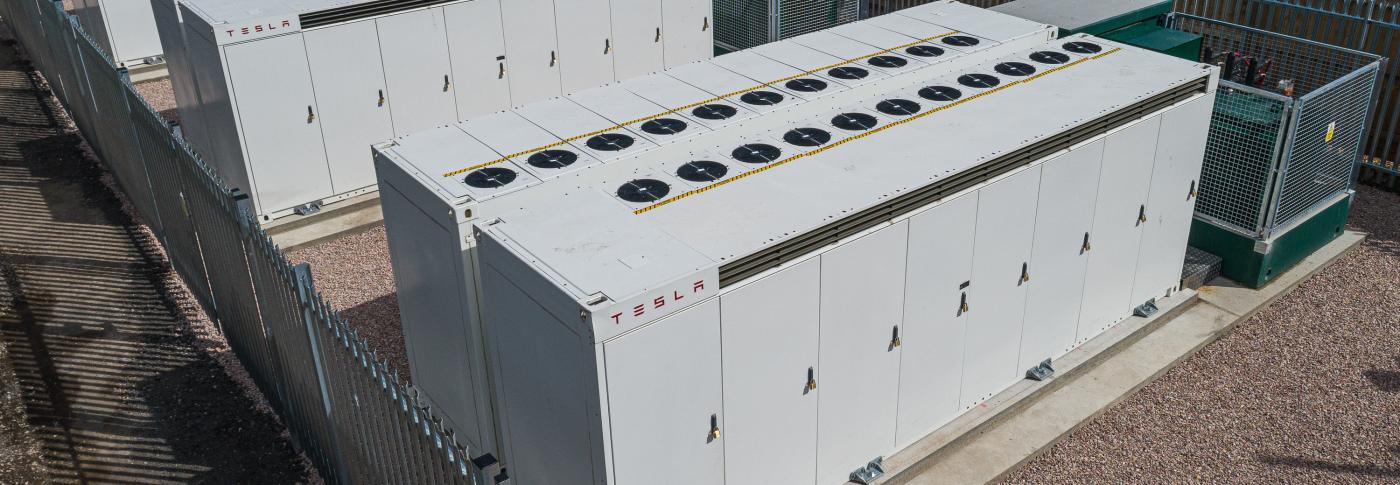
Electricity Explained: Battery storage
25 Sep 2020 - 4 minute read
A battery is a device which stores electricity as chemical energy and then converts it into electrical energy. They’re not in fact a new device and have been around since the early 1800s. Battery technology has of course evolved, and modern lithium batteries are light, powerful and can be used for a range of purposes.
Battery storage is a vital tool that we use to balance the grid and they play a wide range of roles in doing so. The main function is to provide us with artificial inertia and it is stored electricity that can be called upon to provide fast response.
We started using battery storage around 2014 and technology has evolved a lot in under a decade. Battery storage providers usually tend to want a lot of capacity over a short period of time rather than lower capacity over a large time period. The majority of large-scale batteries are be able to provide power for 30-90 minutes now.
There are a number ways batteries can participate in the energy market to help us to balance the grid:
Balancing & Ancillary services:
- Maintain grid frequency – it provides us with enhanced frequency response
- Minimise reserve costs – a fast acting reserve to quickly inject the energy to make up the shortfall
- Minimise foot room costs – foot room is the ability to turn a generator up or down when it isn’t running at full capacity. Injecting electricity from battery storage reduces the foot room and helps us balancing the grid at the lowest possible cost
- Black Start capability – in the unlikely event of a total blackout, we would use the battery power to re-start at a local level. We would then synchronise with the main grid
Transmission Owner/Distribution Network Operator Asset services:
- Minimise TO/DNO reinforcement costs & reduce congestion management - constraints don’t happen all the time so it is often cheaper to add more battery storage contracts rather than upgrade the system
- Keep voltage in limits
Other uses:
- Lower wholesale costs – the wholesale cost of electricity is higher at peak times such as early evening. We are able to store electricity in batteries during low demand periods, and then inject this into the system during peak time. As more battery storage suppliers enter the market, this should reduce costs even more
- Optimise self-consumption – many large factories have solar panels on the roof. On a sunny day they may generate more electricity on site than they can use in a half hour period. This would be stored in the on-site battery and used when required
- Participate in the Capacity Market – battery storage plays its part in the capacity market. It can compete against traditional generation to provide security of supply.
The future of battery storage
Battery storage capacity in Great Britain is likely to heavily increase as move towards operating a zero-carbon energy system.
At the end of 2019 the GB battery storage capacity was 0.88GWh. Our forecasts suggest that it could be as high as 2.30GWh in 2025.
The rise of Battery Electric Vehicles means Vehicle-to-Grid (V2G) will become important. V2G is essentially creating a battery on wheels that we can utilise.
Today most EV owners plug in their vehicles only whenever they need to charge, regardless of the time of day. In future, EV owners will be encouraged to keep their vehicles plugged in. A smart charging system will then decide when is the best time to charge based on time of use tariffs designed to encourage charging when there is excess renewable energy and to avoid charging at times of peak demand. In this instance, V2G would supply energy back to the home or the electricity grid.
This will help network operators to manage electricity supply and maximise use of renewable resources.
Read our Future Energy Scenarios (FES) for more on the future of EVs and V2G technology
As long as the car is plugged in, this resource can be remotely accessed, with little owner intervention required. Of course, there will be occasions when the car needs to be charged at a certain time. But most people’s car usage is fairly predictable and by making sure that car charging infrastructure is available at places of work as well as home.
Battery storage already provides grid balancing services to the ESO today, and we expect this to increase as batteries are deployed more widely in the future.
